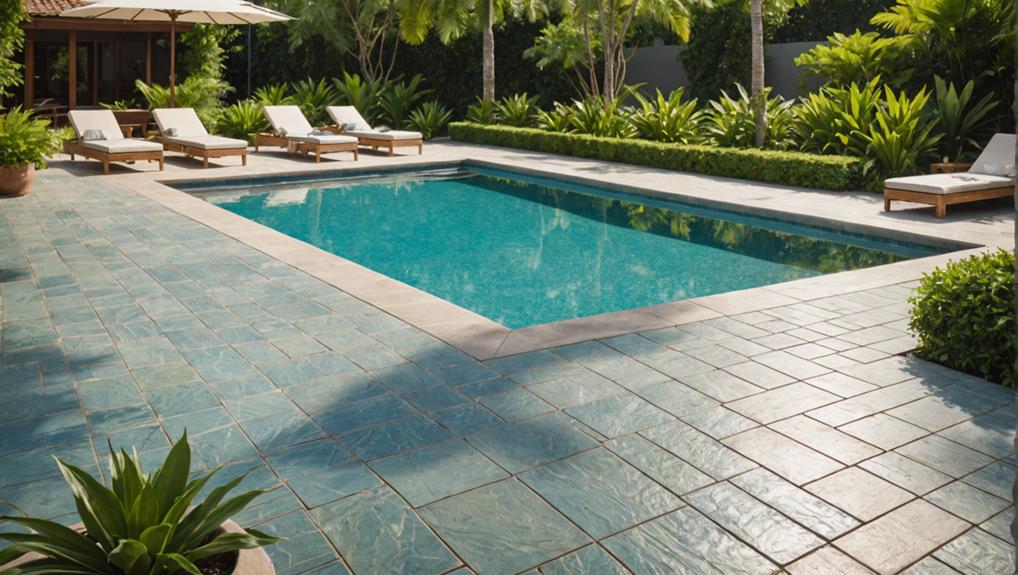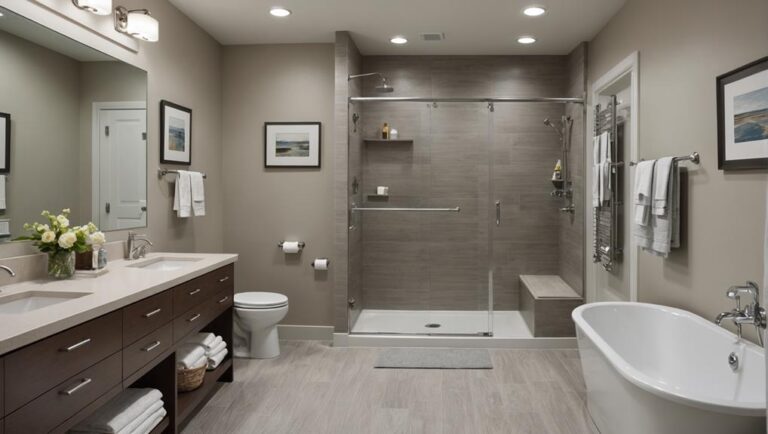Choosing slip-resistant finishes for your poolside floors is essential for safety and aesthetics. Textured surfaces like stamped concrete or textured ceramic tiles increase grip. For coatings, epoxy and polyurethane options provide durability and flexibility. Eco-friendly coatings and anti-slip additives can enhance existing surfaces. Natural materials, such as textured stones like slate and treated bamboo, also offer slip resistance. Regular maintenance prevents algae buildup and maintains integrity. Prioritize finishes that combine safety with design, ensuring compliance with safety standards. If you want to explore more about enhancing your poolside safety, there's plenty more information available to assist you.
Importance of Slip-Resistance
When it comes to poolside areas, you can't overlook the significance of slip-resistance. Ensuring that your poolside piso meets safety regulations is vital for minimizing accidents and enhancing user experience. Wet surfaces can become dangerously slippery, leading to falls that may cause serious injuries. By implementing slip-resistant finishes, you not only adhere to safety standards but also create a more enjoyable environment for users.
Slip resistance is typically measured by the coefficient of friction (COF), which indicates how much grip a surface provides when wet. The higher the COF, the safer the surface will be. Many safety regulations specify minimum COF requirements for poolside areas to reduce the likelihood of slip-and-fall incidents. Compliance with these regulations isn't just about avoiding liability; it's about prioritizing the well-being of those who use the space.
In addition to safety, slip-resistant surfaces considerably improve user experience. Guests are more likely to feel at ease when they know the flooring is designed to minimize the risk of slipping. This peace of mind can enhance overall satisfaction, encouraging repeat visits and positive word-of-mouth recommendations.
It's important to take into account factors such as material selection, texture, and maintenance when choosing slip-resistant options. Regular upkeep of the surfaces is essential, as debris and algae can compromise grip over time. By investing in high-quality slip-resistant finishes and adhering to safety regulations, you're not only safeguarding users but also elevating the quality of the poolside experience.
Types of Slip-Resistant Finishes
When selecting slip-resistant finishes for your poolside, you've got several options to contemplate. Textured surfaces, specialized coatings, and natural materials each have unique properties that can enhance safety and aesthetics. Understanding these choices will help you make an informed decision for your outdoor space.
Textured Surface Options
Choosing the right textured surface options for slip-resistant finishes is essential for enhancing safety around poolside areas. Various textured patterns can be employed to increase traction and minimize slip risks, especially when surfaces are wet.
One effective option is stamped concrete, which uses patterns that create a non-smooth finish. This not only adds aesthetic appeal but also provides a grip that helps prevent slips. Another popular choice is textured ceramic tiles, often featuring raised patterns that enhance surface friction.
You might also consider surface treatments like sandblasting or acid etching, which modify existing surfaces to create a more slip-resistant texture. These treatments can be applied to concrete, paving stones, or even existing tiles, making them versatile solutions.
Additionally, rubberized flooring options often feature built-in textured patterns that offer excellent slip resistance and comfort. Always verify that the chosen textured surface options meet safety standards and are suitable for your specific poolside environment. By prioritizing these slip-resistant finishes, you greatly reduce the likelihood of accidents, creating a safer space for everyone.
Coating Products Overview
After selecting the right textured surface options, the next step is to explore various coating products that enhance slip resistance. These coatings come in different formulations, each tailored to specific safety needs and environmental considerations.
| Coating Type | Características principales | Técnicas de aplicación |
|---|---|---|
| Epoxy Coatings | Durable, chemical-resistant, strong adhesion | Roll-on or spray application |
| Recubrimientos de poliuretano | Flexible, UV-resistant, suitable for outdoor use | Roll-on or brush application |
| Eco-Friendly Coatings | Made from natural materials, low VOC emissions | Spray or roll-on techniques |
| Anti-Slip Additives | Improves traction without altering appearance | Mixed into existing coatings |
When selecting a coating, consider its eco-friendly properties if sustainability is a priority. Application techniques can vary; roll-on methods are common for ease, while spray techniques provide a smooth finish. Always follow manufacturer guidelines for best results, ensuring that the coating bonds well and provides the necessary slip resistance. By understanding these options, you can make informed decisions to enhance safety around your poolside areas.
Natural Material Choices
Several natural material choices can greatly enhance slip resistance for poolside finishes. Opting for materials like textured stone, such as slate or travertine, provides an excellent balance of safety and aesthetic appeal. These materials have inherent rough surfaces that increase traction, reducing the risk of slips when wet.
Another viable option is recycled rubber, which not only offers slip resistance but also delivers eco-friendly benefits. This material is made from repurposed tires, making it a sustainable choice for environmentally conscious homeowners. Rubber surfaces can effectively absorb water, minimizing puddling and further enhancing safety.
Additionally, bamboo is gaining popularity due to its rapid renewability and attractive appearance. When treated properly, bamboo can withstand moisture while providing a slip-resistant surface that complements outdoor designs.
Lastly, consider using natural cement finishes infused with aggregates like quartz or sand. These mixtures can be tailored to achieve desired textures and colors, ensuring you maintain both safety and aesthetic appeal. By selecting these natural materials, you're not only prioritizing safety but also choosing eco-friendly options that enhance your poolside environment.
Materials for Poolside Flooring
When selecting materials for poolside flooring, you'll want to contemplate both natural stone options and composite decking solutions. Natural stone provides durability and aesthetic appeal, while composite materials offer low maintenance and enhanced slip resistance. Each choice has unique benefits that can influence safety and design in your pool area.
Natural Stone Options
Natural stone options for poolside flooring offer a blend of aesthetic appeal and functional benefits, making them a popular choice among homeowners. When selecting natural stone, consider materials like travertine, limestone, and slate, which not only enhance the beauty of your outdoor space but also provide slip-resistant surfaces.
To maximize safety, it's crucial to apply appropriate stone treatments, such as sealants and textured finishes. These treatments increase traction, reducing the risk of slips and falls, especially when the surface is wet. Travertine, for instance, is known for its porous nature, allowing better grip underfoot, while limestone provides a soft, natural look with good slip resistance. Slate offers a variety of colors and textures, which can further enhance your poolside's visual appeal without sacrificing safety.
Before making a final decision, verify you test the stone's slip resistance rating and confirm that it meets industry safety standards. By choosing the right natural stone and applying effective treatments, you can create a beautiful, inviting, and safe poolside environment for family and friends to enjoy.
Composite Decking Solutions
Composite decking solutions are increasingly becoming a favored choice for poolside flooring due to their blend of durability, low maintenance, and inherent slip resistance. These materials consist of a mix of wood fibers and recycled plastic, making them resistant to moisture and rot. This is vital for poolside environments, where water exposure is constant.
When considering design aesthetics, composite decking comes in a variety of colors and textures, allowing you to create a visually appealing space that complements your pool area. This flexibility guarantees that you can achieve the desired look without compromising safety.
In terms of installation techniques, composite decking is designed for straightforward assembly, often featuring interlocking systems that minimize gaps. This reduces the chances of slips and falls, enhancing safety around the poolside. Additionally, many composite products come with a textured surface, further improving traction.
Benefits of Slip-Resistant Surfaces
Safety is paramount in any poolside environment, making slip-resistant surfaces an essential feature. When you choose slip-resistant finishes, you're prioritizing the well-being of everyone who uses the area. These surfaces greatly reduce the risk of slips and falls, which can lead to serious injuries, especially in wet conditions. By adhering to established safety standards, slip-resistant materials provide you with peace of mind, knowing that your poolside is designed with safety in mind.
Beyond safety, slip-resistant surfaces also enhance design aesthetics. You don't have to compromise on style while pursuing functionality. Modern slip-resistant finishes come in various textures and colors, allowing you to create an inviting and visually appealing environment. Whether you prefer a sleek, contemporary look or a more classic style, there are options that fit your design vision.
Moreover, these surfaces can improve the overall longevity of your poolside area. Their durability means they can withstand heavy foot traffic and exposure to water, maintaining their performance over time. This not only secures safety but also minimizes the need for frequent replacements or repairs.
Incorporating slip-resistant surfaces into your poolside design is a smart choice. It provides safety benefits while enhancing the aesthetic appeal of the area. By investing in these finishes, you're fostering a safe, stylish, and welcoming environment that can be enjoyed by all, ensuring that your poolside remains a relaxing oasis.
Consejos de mantenimiento para una mayor longevidad
While maintaining slip-resistant finishes for your poolside floors may seem straightforward, proper care is paramount to guarantee their longevity and effectiveness. Regular cleaning techniques play an essential role in preserving the integrity of these surfaces. Use a mild detergent mixed with water and a soft-bristle brush to remove dirt, algae, and chlorine residues. Avoid abrasive cleaners, as they can damage the finish and reduce slip resistance.
In addition to regular cleaning, implementing seasonal inspections is critical. At the beginning of each season, thoroughly examine the poolside area for any signs of wear, such as cracks or discoloration. Pay special attention to areas that receive more foot traffic, as these are more prone to deterioration. Early detection of issues allows you to address them promptly, preventing further damage and maintaining safety.
Furthermore, consider applying a sealant specifically designed for slip-resistant finishes every few years. This helps to rejuvenate the surface and enhance its protective qualities. After heavy rainfall or pool usage, verify that the area is free from standing water, as this can lead to slippery conditions.
Lastly, educate all pool users about the importance of not using glassware or other slippery items near the poolside. By following these maintenance tips and incorporating proper cleaning techniques and seasonal inspections, you can greatly extend the lifespan of slip-resistant finishes, assuring a safe environment for everyone.
Elegir el acabado adecuado
Selecting the right finish for your poolside floors is crucial to guarantee both safety and durability. When choosing a finish, you should prioritize slip resistance, as wet surfaces can lead to accidents and injuries. Consider finishes that meet or exceed industry standards for slip resistance, such as textured coatings, anti-slip tiles, or treated concrete surfaces.
It's also essential to balance functionality with design aesthetics. You want a finish that not only provides safety but also complements your outdoor space. Look for finishes that come in various colors and textures, allowing you to enhance the overall look of your pool area while maintaining a safe environment.
Additionally, you should consider the environmental impact of your chosen finish. Some materials may contain harmful chemicals that can leach into the water or surrounding soil. Opt for eco-friendly options, such as water-based sealants or sustainably sourced materials, which minimize negative effects on the environment while ensuring a safe surface for users.
Lastly, don't forget about maintenance requirements. Some finishes require more upkeep than others, which can affect long-term safety and durability. Evaluate how much time and resources you're willing to invest in maintaining your poolside floors.
Preguntas frecuentes
How Do Slip-Resistant Finishes Affect the Aesthetics of Poolside Areas?
When considering how slip-resistant finishes affect aesthetics, you'll find that design considerations play a vital role. These finishes can be tailored to blend seamlessly with your overall theme, ensuring safety without compromising style. You've got various color options that can enhance the visual appeal of your poolside area while providing the necessary grip. Ultimately, choosing the right finish can create an inviting atmosphere that prioritizes safety along with a pleasing design.
Are There Specific Slip-Resistant Finishes for Different Climates?
Isn't it essential to contemplate how climate affects your choices? Different climates necessitate specific slip-resistant finishes tailored to local conditions. For instance, in humid areas, textured options like rubberized coatings can provide excellent grip, while arid climates might benefit from specialized sealers that withstand heat. Always keep climate factors in mind when selecting materials, as the right finish not only guarantees safety but also enhances the longevity of your surfaces.
Can I Apply a Slip-Resistant Finish Over Existing Poolside Flooring?
Yes, you can apply a slip-resistant finish over existing poolside flooring, but it's essential to guarantee the surface is clean and in good condition. For ideal pool safety, follow maintenance tips like repairing any cracks or damages before application. This not only enhances traction but also prolongs the life of your flooring. Confirm you choose a compatible product for best results, keeping your pool area safe and enjoyable for everyone.
Do Slip-Resistant Finishes Require Special Cleaning Products?
So, you think you can just waltz in with any old cleaner and expect your slip-resistant finish to shine? Think again! These finishes often require specific cleaning techniques and product recommendations to maintain their safety features. Using harsh chemicals or abrasive tools can wear them down. Stick to pH-balanced cleaners and soft mops to keep your surface safe and slip-resistant. After all, you wouldn't want a slip-up on your watch!
How Long Do Slip-Resistant Finishes Typically Last Before Needing Replacement?
Slip-resistant finishes generally last between five to ten years, depending on durability factors like foot traffic, weather exposure, and maintenance tips. Regular cleaning and inspections can considerably extend their lifespan. If you notice wear or reduced effectiveness, it may be time for a replacement. Always consult product specifications for manufacturer recommendations and consider professional assessments to guarantee peak safety and performance over time. Prioritizing maintenance can enhance both safety and longevity.




